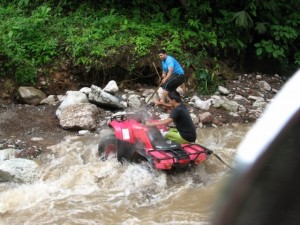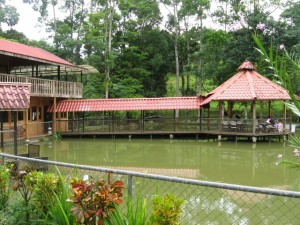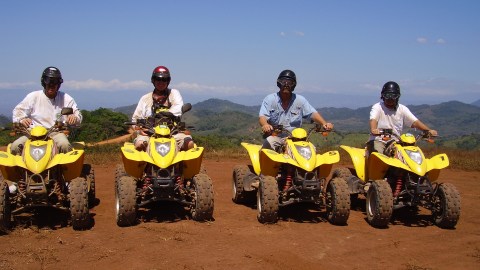Costa Rica Travel News – “We can’t go all the way to the waterfalls,” our guide, Ivan, told us as we strapped on our helmets for an ATV tour of the mountains above Jacó. “The roads are too dangerous because of the rain yesterday.”
We had come to Costa Rica during the rainy season because we knew the beaches would be less crowded, the hotel rooms would be cheaper and easier to find, and the whitewater would – hopefully – be raging. Technically, it’s the “rainier” season because Costa Rica is largely rainforest, but we knew what we were getting into.
Then again, maybe we didn’t. Although we expected some precipitation, the previous night’s rains came down in unrelenting little fists, soaking anyone venturing into it for even five seconds, turning the bustling tourist beach area into a ghost town, closing many restaurants, and flooding the entire ground floor of our hotel in two feet of drainage overflow. Jacó was used to getting regular downpours, but this was a drenching to remember.
 Ivan, a native Tico, as Costa Ricans call themselves, was also amazed by the previous night’s weather. “That’s the most we got rain this year.”
Ivan, a native Tico, as Costa Ricans call themselves, was also amazed by the previous night’s weather. “That’s the most we got rain this year.”
But he assured us he would find a good road up the mountain, that we would fly around bumpy roads, some of them half-washed away by the downpour, and that lunch at a remote tilapia farm was waiting for us. And since it was the low season, late August, we had the tour to ourselves. Ivan on the lead bike, and my wife and I on the second.
I’m a city boy who has never thumbed the throttle on a 4-wheeled ATV, so I was insanely excited, despite being denied the waterfall portion we were looking forward to. Ivan said that we could try to take the steep road that led down to the waterfalls, but then thought twice about it. He’d been tearing around his hometown on ATVs for almost two decades, but even he was worried about the road’s stability.
Fifteen minutes into our ride, the full force of the storm’s impact started to become clear. At the very bottom of the mountains’ foothills, the one road that led up had been washed out. As in gone. A couple of moss-covered logs were thrown across the gap to allow people to walk across, but there was no road for our ATVs to make it across.
Now, the guide books will tell you to expect to make a few small creek or river crossings if you decide to drive around Costa Rica at this time of year, and even though the insurance rental agencies are required to sell doesn’t cover water damage (a real risk for water-crossing newbies), I was still looking forward to the opportunity to actually ford a river. What I had pictured was something like a Jeep commercial, where my trusty 4-wheel-drive would skip lightly over a pebble-strewn riverbed.
No.
The river took that road and the entire concrete bridge it rested on and destroyed them – made them into a  collection of boulders pushed downstream. The water itself was brown, thigh-deep, and violent. The emergency road crews that were constantly busy cleaning up after mother nature’s tantrums hadn’t yet arrived, so crossing with our ATVs was challenging – to put it mildly.
collection of boulders pushed downstream. The water itself was brown, thigh-deep, and violent. The emergency road crews that were constantly busy cleaning up after mother nature’s tantrums hadn’t yet arrived, so crossing with our ATVs was challenging – to put it mildly.
A third ATV-rider pulled up to the blocked passage – a local and a friend of Ivan’s – and together, they worked to get the three bikes on the other side. Strong lines were tied to ends of the ATVs, in case the river proved too strong and swept the 4-wheelers away. With one arm on the throttle and one leg on the side, ready to jump free if the river snatched the bike from beneath him, Ivan carefully chose a path around the river’s larger boulders and punched through. The half-dozen people gathered around applauded. We followed through on foot, glad we were dressed in swim gear and Tevas.
We hadn’t even begun to climb the mountain, and it was already worth the price.
What followed was more than two hours of breathtaking views, portions of road that had been reduced to a width of only a couple of feet due to early morning mudslides, and the tension from being unable to decide whether to keep an eye on the crumbling road beneath us, or on the vista around us.
Halfway to our lunch stop, we took a break at a small soda, a kind of family-run restaurant that can be found all over Costa Rica. Rancho Shadday (“Welcome to the place where there is no Earth crisis”) is a beautiful country restaurant, completely open air, located smack dab in the middle of nowhere, but with seating for a couple of dozen people. I imagine the talented abuelitabehind the counter was much busier during the high season, as herempanadas and chicharrónes alone were worth the drive.
We ate lightly but bought drinks for the rest of our trip. We hooted and shouted on our way further up, and Ivan did too. There was singing, but it was hard to hear over the engines.
 When we finally got to the tilapia farm, we were famished. We had the option to catch our own lunch, or have them get started and fish for replacement tilapia while we waited. Though my wife caught one, the cook took it in to clean it for the next meal. It was a simple lunch of fried fish, rice, plantains, and salad – typical Costa Rican fare, but all the more delicious because it was caught earlier that day.
When we finally got to the tilapia farm, we were famished. We had the option to catch our own lunch, or have them get started and fish for replacement tilapia while we waited. Though my wife caught one, the cook took it in to clean it for the next meal. It was a simple lunch of fried fish, rice, plantains, and salad – typical Costa Rican fare, but all the more delicious because it was caught earlier that day.
The ride back down the mountain was every bit as fun as the trip up, and though we didn’t have the opportunity to visit the waterfall, the repair crews were already at work trying to jerry-rig a passable road. A back hoe had piled some of the larger boulders a bit upstream, and the flow had calmed a little. But it was enough that, after riding straight through the river without the effort needed on the way up, Ivan encouraged me to ride through myself.
So we did. Slow, slow, but steady – don’t stop, or the water could flood the tailpipe. Then gun it! We almost flipped, caught some air, and landed hard – though not too hard. We were laughing uncontrollably, and so was Ivan. Even our somewhat-jaded tour guide was having a great time.
And when, like clockwork, the skies opened up again and soaked us for the last 20 minutes of our trip back into town, we didn’t mind one bit.
We were already soaked. It’s part of the reason we chose to visit Costa Rica during the rainy season, and the jungle did not disappoint.
John Giuffo, Contributor Forbes.com

